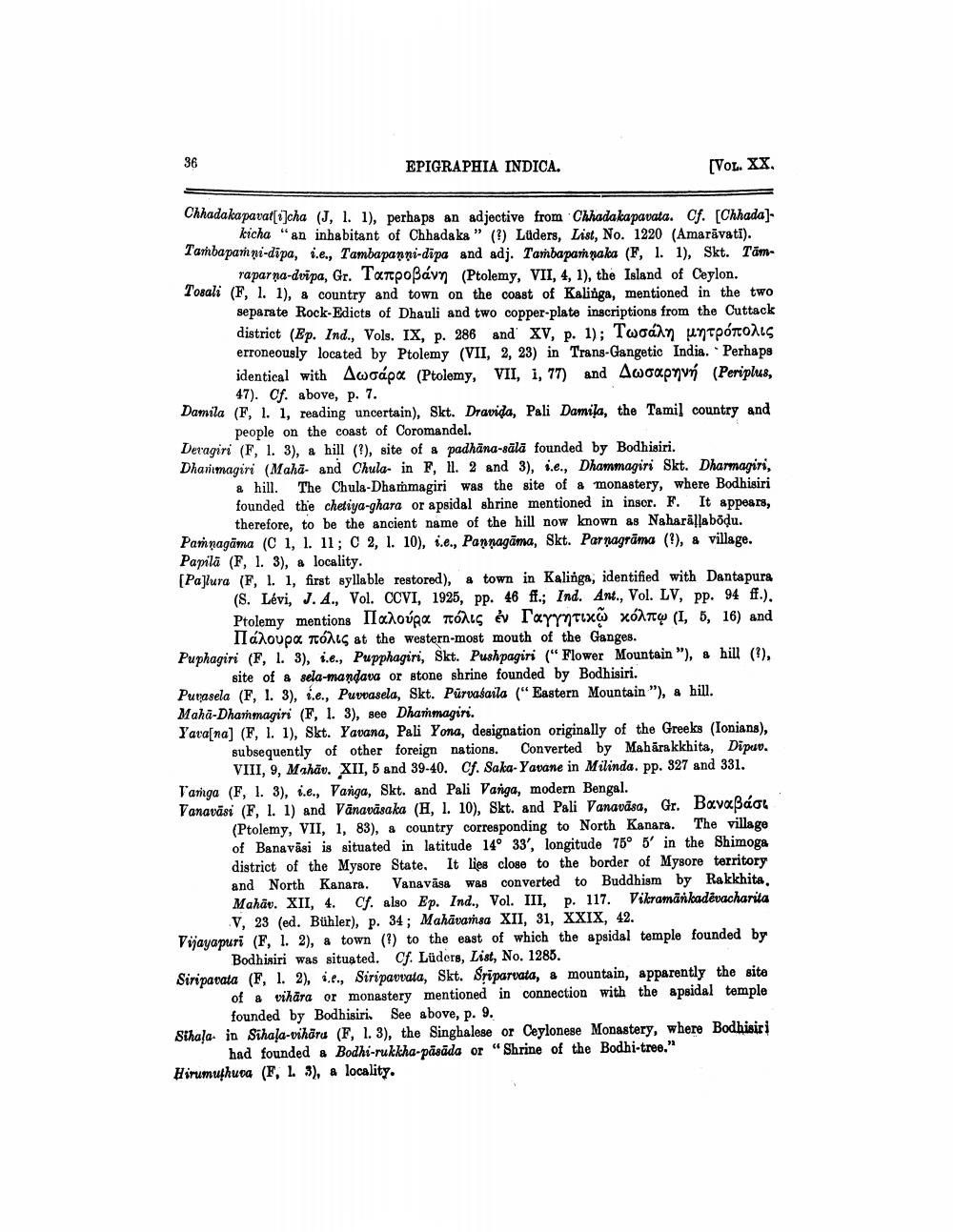________________
EPIGRAPHIA INDICA.
[VOL. XX
Chhadaka pavat[i]cha (J, I. 1), perhaps an adjective from Chhadaka pavata. Cf. [Chhada).
kicha "an inhabitant of Chhadaka " () Lüders, List, No. 1220 (Amarāvati). T'ambapan ni-dīpa, i.e., Tambapanni-dipa and adj. Tambapan paka (F, 1. 1), Skt. Täm
raparna-dvipa, Gr. Tarpoßávn (Ptolemy, VII, 4, 1), the Island of Ceylon. Tosali (F, 1. 1), & country and town on the coast of Kalinga, mentioned in the two
separate Rock-Edicts of Dhauli and two copper-plate inscriptions from the Cuttack district (Ep. Ind., Vols. IX, p. 286 and' xv, p. 1); Twoaan untpótto LS erroneously located by Ptolemy (VII, 2, 23) in Trans-Gangetic India. Perhaps identical with Awoápa (Ptolemy, VII, 1, 77) and Awoapvn (Periplus,
47). Cf. above, p. 7. Damila (F, I. 1, reading uncertain), Skt. Dravida, Pali Damila, the Tamil country and
people on the coast of Coromandel. Deragiri (F, 1. 3), a hill (?), site of a padhāna-sālā founded by Bodhisiri. Dharimagiri (Maha. and Chula. in F, 11. 2 and 3), i.e., Dhammagiri Skt. Dharmagiri,
a hill. The Chula-Dhammagiri was the site of a monastery, where Bodhisiri founded the chetiya-ghara or apsidal shrine mentioned in insor. F. It appears,
therefore, to be the ancient name of the hill now known as Naharāļļabodu. Pamnagāma (C1, 1. 11; C 2, 1. 10), i.e., Pannagāma, Skt. Par nagrāma (?), & village. Papilä (F, I. 3), a locality. [Pallura (F, 1.1, first syllable restored), a town in Kalinga, identified with Dantapura
(S. Lévi, J.A., Vol. CCVI, 1925, pp. 46 ff.; Ind. Ant., Vol. LV, pp. 94 ff.). Ptolemy mentions IIaloup TÓALS év TayyntiX X6W (, 5, 16) and
Il áloupa tóg at the western-most mouth of the Ganges. Puphagiri (F, 1. 3), i.e., Pupphagiri, Skt. Pushpagiri ("Flower Mountain"), a hill (9),
site of a sela-mandava or stone shrine founded by Bodhisiri. Putasela (F. 1. 3), i.e., Puvvasela, Skt. Purvasaila ("Eastern Mountain"), a hill. Maha-Dhanmagiri (F, I. 3), see Dhanmagiri. Yava[na] (F, 1. 1), Skt. Yavana, Pali Yona, designation originally of the Greeks (Ionians).
subsequently of other foreign nations. Converted by Maharakkhita, Diput.
VIII, 9, Mahão. XII, 5 and 39-40. Cf. Saka-Yavane in Milinda. pp. 327 and 331. Varga (F, 1. 3), i.e., Vanga, Skt. and Pali Varga, modern Bengal. Vanaväsi (F, 1. 1) and Vänavāsaka (H, I. 10), Skt. and Pali Vanaväsa, Gr. Bovabáol
(Ptolemy, VII, 1, 83), a country corresponding to North Kanara. The village of Banavāsi is situated in latitude 14° 33', longitude 75° 5' in the Shimoga district of the Mysore State. It lies close to the border of Mysore territory and North Kanara. Vanaväsa W&converted to Buddhism by Rakkhita. Mahāv. XII, 4. cf. also Ep. Ind., Vol. III, p. 117. Vikramärkadēvacharita
V, 23 (ed. Bühler), p. 34; Mahāvamsa XII, 31, XXIX, 42. Vijayapuri (F, 1. 2), a town (?) to the east of which the apsidal temple founded by
Bodhisiri was situated. Cf. Lüders, List, No. 1285. Siriparata (F, 1.2), ie., Siripavvata, Skt. Sriparvata, & mountain, apparently the site
of a vihara or monastery mentioned in connection with the apsidal temple
founded by Bodhisiri. See above, p. 9. Sthala. in Sihaļa-vihoru (F. 1. 3), the Singhalese or Ceylonese Monastery, where Bodhisiri
had founded a Bodhi-rukkha-pāsāda or "Shrine of the Bodhi-tree." Hirumuthuva (F, L. 3), a locality.




